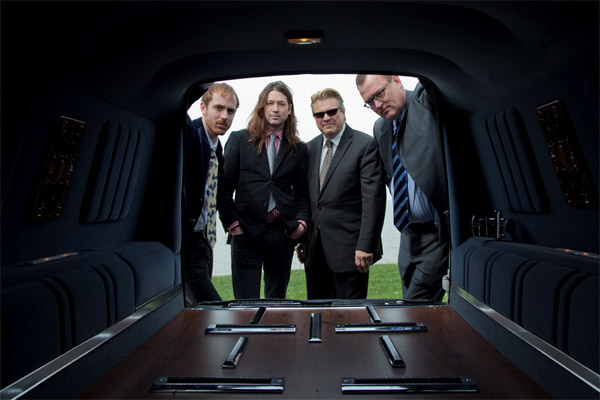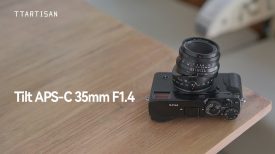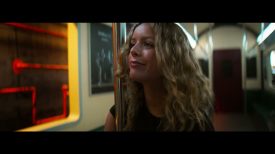Guest post by Micha Hilliard

“Vacuuming just happens to be one of my passions,” exclaims Walter during his interview. He goes on to list the virtues of his German water-based Hyla vacuum cleaner. My crew and I are set up in a luxuriant parlour at “Walter A. Frey Funeral Home,” surrounded by chandeliers and Chinese porcelain. The interview has turned to the subject of embalming. I cast a sideway glance at the polished mahogany casket in the adjoining room and wonder how I’ve ended up in this place with a production team and a pile of costly equipment.
Walter from Art+Practice on Vimeo.
Back in 2010, director Mika Johnson and I shot the first episode of ‘The Amerikans’, a series that takes a local and collaborative approach to documentary filmmaking. Our goal was to reveal the extraordinary richness of the lives of ordinary people in Northeast Ohio. We wanted to bring together disparate communities. At the time, I was an undergraduate student and we had to schedule all our shoots around my classes. We did not own any equipment. The cameras we ended up using, the JVC GY-HM100U and Panasonic AG-HVX200, belonged to the film department at my university. Equipped with them and a vision, which our producer Jeff Pence helped us to articulate, we set out into the corn fields to tell the story of Tom Tomes, a farmer, diesel mechanic, and hunter.
During the first day of production, we led Tom into an open pasture and asked him to shoot blanks at the camera. We also made him pose on a stack of hay and arranged deer skulls behind him. It was clear from the beginning that both Mika and I would be breaking common documentary practices with ‘The Amerikans’. We weren’t interested in capturing reality exactly as we found it, since reality is often unorganized, unpredictable, and in the case of Tom hunting, even perilous. Instead, the decision was reached with Jeff to script the episode with the help of a few preliminary audio interviews. Tom provided the material, but we put it in order. When possible, we asked him to repeat his actions so the camera could be repositioned. His farm had the feel of a fiction film set.
Cowboy Action from Art+Practice on Vimeo.
The reason I do not hesitate in describing ‘The Amerikans’ as non-fiction is because we involve our subjects, who are non-actors, in every stage of production. They have final cut. Rather than imposing our ideas, we enable them to conceptualise and act out their own. To turn this theory into practice took time and experience. Initially, it was unnerving to want to give up control, since so much of filmmaking is about exerting control. Mika and I had to teach ourselves to withhold ego and judgement. Only upon meeting Ethel Moyers, a collector of more than two thousand paper napkins and our seventh subject, did we feel prepared to let go. She wrote her own script and acted the role of herself, as she conceived it. The script was a commentary on a great number of her napkins and turned out to be a fan favourite. Non-fiction is always more interesting than fiction.
Napkin Tales from Art+Practice on Vimeo.
As our method developed, so did technology around us. For Ethel’s episode, we were able to get our hands on a friend’s Panasonic AG-AF100. I remember the exultation I felt as I pulled my first accurate focus and interchanged two lenses. A new door was opened. Before long, my film department invested in a small number of Canon EOS 7D cameras. There was no going back once I got to using them. The DSLR revolution dramatically improved the look of the episodes and added a sense of professionalism. It also broadened the range of subjects we could follow. Right away, Mika had me climbing on top of freight cars with a graffiti artist named Fixer, while looking out for rail workers himself. Episode nine was almost entirely shot on a monopod, due to the light weight of DSLRs.
Once I graduated from university, I had much more time to put into ‘The Amerikans’. Our process slowed down and scenes became increasingly elaborate and set up. Jeff arranged for the series to screen on public television and receive a number of grants from local community foundations. By the time we arrived at ‘Walter A. Frey Funeral Home’, our production crew had more than doubled and we had access to an 8 foot track, jib, two Canon 5Ds, and a light kit. There was even a box of fresh doughnuts awaiting Mika and I each morning. We could not have imagined this course of events, back when we stood in Tom’s skinning room twelve episodes ago. It shows that there are creative approaches to filmmaking that are not reliant on the commercial film industry. We decided to work locally and in close participation with our subjects, and it has paid off.
Love & Venom from Art+Practice on Vimeo.






